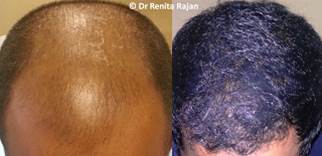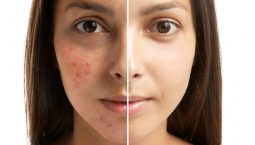The major conditions associated with hair fall in men are male pattern baldness, autoimmune hair loss and rarely, nutritional causes. In women, genetic tendency, nutritional deficiencies, delivery and breastfeeding, stress induced hair loss and autoimmune conditions are the leading causes of hair loss.Apart from providing the latest medical treatments for these problems, Dr Renita Rajan Skin & Hair Clinic specializes in minimally invasive hair restoration therapies.
One of the few clinics in India to have an excellent outcome rate in hair transplantation using the FUE technique, our success rate is attributable directly to our patient selection process. Based on an initial Follicular Extraction Test (FOX test), progression of hair loss, donor area health and patient characteristics, an algorithm is drawn up which gives an idea about the success rate for a given patient. Where criteria indicate a less than optimal outcome, medical and adjuvant therapies are used to improve upon the outcome of an eventual hair transplantation surgery.
Hair transplantation is an option for both men and women with pattern (androgenetic) hair loss. The transplanted hair is obtained from the permanent hair bearing part of the scalp to ensure its longevity in the transplanted area. No admission is required, and the individual may return to work within a day or two after the surgery.
FUE is a relatively newer technique of hair transplantation, which has progressed greatly from the initial days, to be come a reliable and comfortable way of hair transplantation. Owing to a lot of refinements in the technique, FUE is fast becoming as popular, or even more popular, than FUT, as a means of surgical hair replacement. The major advantage that FUE has over FUT is the absence of a visible surgical scar. This allows the person undergoing the transplant to wear their hair very short, or even sport a total shave once in a while. The recovery period is also very short, since the smaller (<1 mm) extraction sites heal within 3 -5 days after the procedure.
Pre surgical assessment for FUT/ FUE involves a complete blood work up, assessment of the area to be grafted, donor density, likelihood of hair loss to progress, scalp laxity and general health of the patient.
In addition, prospective FUE patients will also undergo a test called the Follicular Extraction Test (FOX), which will give an idea about the extractability of the grafts, the nature of the scalp, and this will help decide whether the patient will likely be a good candidate for the FUE procedure. It is mandatory to undergo the FOX test prior to planning an FUE session.
Once the FOX test is favourable, the next step is to plan an FUE session. At Dr Renita Rajan Skin & Hair Clinic, we undertake sessions of upto 2000 grafts in a day. Larger sessions will be planned over 2 sittings, or the patient will be given the option of considering an FUT, if found fit for the same. The first step in the FUE protocol at Dr Renita Rajan Skin & Hair Clinic is creation of recipient sites, using tumescent technique. The patient then goes into the face down position on the custom made transplant chair, which allows for comfortable extraction of the grafts from the donor area. We take great care not to allow transections of the follicular units and are easily able to extract even 4 hair grafts without any transection – using multiple innovative techniques in both punching the graft and then in extracting it. Then, once the extraction of the planned number of grafts is over, the grafts are carefully inserted into the created recipient sites, where by now, complete hemostasis is already achieved. This step is also aided by implanters, where recipient sites have been created at less than 0.7 cm.
Aftercare involves washing the donor area from the very next day, and then applying antibiotic cream, and washing the recipient area 48 hours after the surgery. The donor area will start returning to its normal look within 3-4 days after surgery and will completely look covered within a month after surgery. The top portions of the grafts on the recipient site will start shedding from the 7th to 10th day after surgery, leaving behind the lower growing part of the follicle from which permanent hair grows out from the 6 week onwards. However, complete growth of the grafts may go on even upto 9 month to 1 year after the surgery.
In FUT, a linear strip of tissue is obtained from the occipital scalp (back of the head), and the wound is closed by trichophytic closure which greatly aids in minimising scar visibility. Next the strip is sectioned to provide hundreds to a few thousands of transplant units (as decided during the pre surgical assessment and planning) and finally, these units are implanted into specially created slits in the recipient area. While the donor wound is kept under bandage for a day or two, no dressing is needed for the recipient area. Since the donor area is closed with an absorbable suture there is no need for suture removal. The transplant recipient may go home the same day, with instructions for wound and graft care.
Your Age: The selection of a candidate for hair transplant takes into account the possibility of further balding with age. While hair patterns usually stabilize in the late twenties to early thirties, a careful history and examination to ascertain the pattern will help in making the decision of whether or not to transplant. Teenagers, even though they may insist on an immediate transplant, are gently explained about the process and the implications and are advised medical measures. It may be said that age 25 and above may be considered for transplant, provided the clinical assessment supports this decision.
Your General Health: You need to be healthy, in order to undergo this procedure. We check for factors like diabetes, hypertension, anemia, viral illness (including a detailed screening for HIV and Hepatitis viruses), clotting and bleeding tendencies – all of which need to be okay, before we start to plan the procedure.
Anesthetic Fitness: You must be certified to be fit for anesthesia, by our Clinic’s Anesthetist before we go ahead with planning a date. While you may choose to get additional clearances from other doctors of your choice, we will accept the fitness certificate, only if you have been evaluated in detail, in person, by Dr Subhas, our Anesthetist, as you will be under his care for the day of the procedure. This is a mandatory requirement.
Smoking: Smoking can increase the bleeding during the procedure, and interfere with the final outcome of the surgery. We have right to refuse the procedure for you, if we feel, that your smoking is a significant deterrent to the outcome of the surgery.
Time to planning a surgery: Hair transplants are not medical emergencies, and we follow a protocol that ensures patient safety and superior outcomes. The planning of a procedure may take anywhere between 2 to 4 weeks, depending on the wait list. Also, for medical reasons, longer wait periods may be considered. Please consider this while planning your treatment at our Clinic, especially if you do not reside in Chennai.
Need for Repeat Procedures: We plan each procedure as a stand alone surgery. However, in patients with extensive hair loss, a second session may be planned after discussion with the individual. This would ideally be scheduled a year after the first session, to allow maximal hair growth after the first transplant. A large session may be done over 2 days, but will still be considered as the first sitting.










